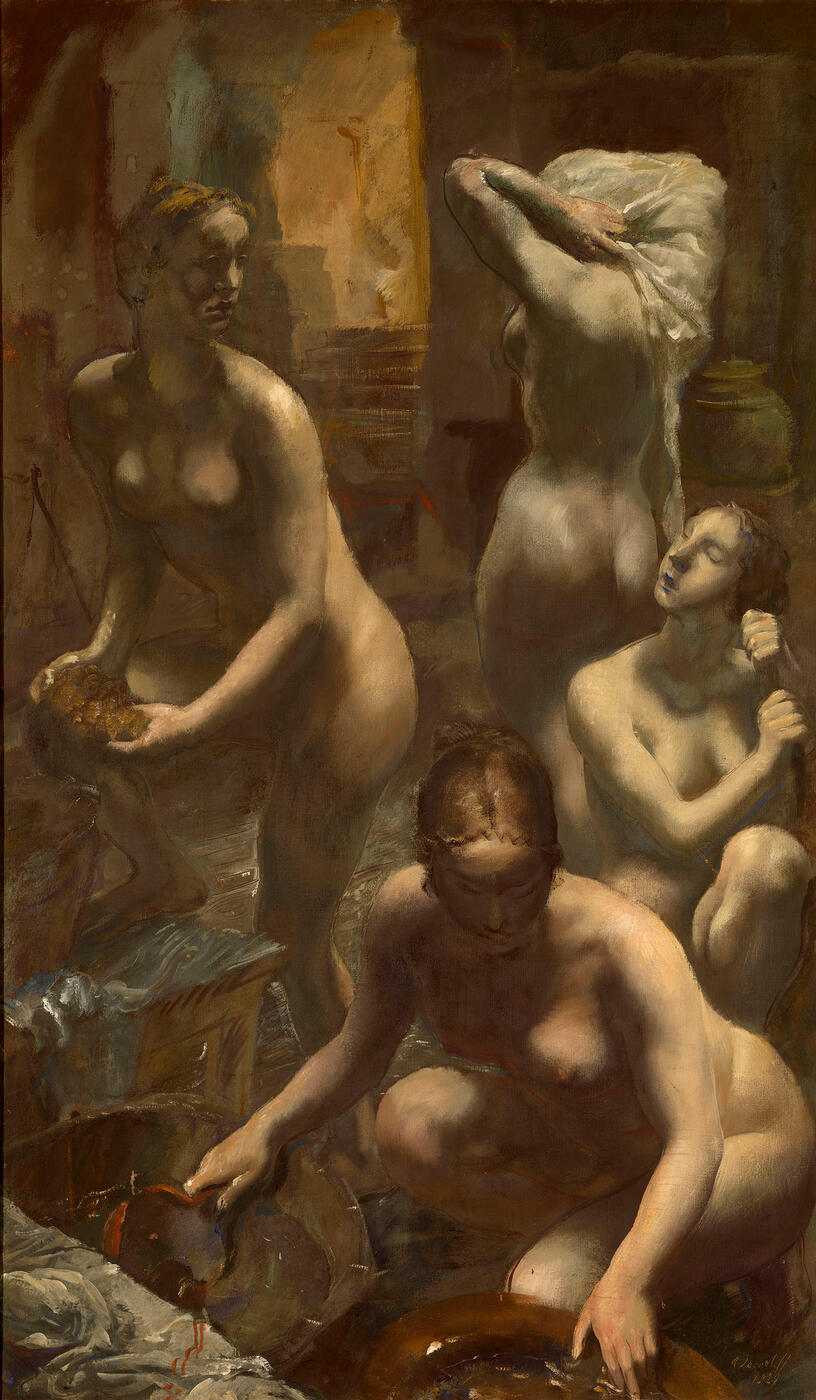MacDougall's Russian Art Auctions 27-30 May 2012
27 May 2012

13. YAKOVLEV, ALEXANDER (1887-1938)
Nudes Bathing, signed and dated 1929.
Tempera on canvas, 155 by 92 cm.
750,000–900,000 GBP
Provenance: The artist’s estate.
Acquired from the above by Vose Galleries, Boston, 1948.
Reacquired from the above by the artist’s estate, 1956.
Collection of Roger Prigent.
Anonymous sale; Modern and Contemporary Paintings, Drawings and Sculpture, Sotheby’s New York, 28 February 1992, Lot 120.
Anonymous sale; Russian Art, Sotheby’s New York, 17 April 2007, Lot 335.
Private collection, UK.
Exhibited: Alexandre Iacovleff Memorial Exhibition, Fitchburg Art Museum, Fitchburg, January–February 1954.
Alexander Yakovlev’s painting Nudes Bathing is a kind of summation of his work over many years on the theme of the nude. The largest of all Yakovlev’s 1929 Parisian works on this subject, it combines the artist’s new researches into colour with his development of his beloved image of the Russian bath-house and expressive Neoclassical form. At the same time, alongside the artist’s obvious interest in the 17th-century Old Masters, the influence of Cézanne’s Baigneuses is clearly discernable.
The painting preserves a legacy from the art of former times: a sense of allegory about the female forms, each of them incorporated in a circle and simultaneously turned side-on towards the viewer, a difference of scale in the portrayal of primary and secondary subject matter, a localisation of colour, a smoothness in the manner of execution, glazes, and a brown academic
background. The severe, almost monochrome, use of colour nonetheless brings out as vividly as possible the sensuous, young, statuesque figures of the women, at different heights, in motion and forming a circle. The treatment of the nudes, their corporality and bevelled structural quality strongly recall Cézanne.
Yakovlev rejected much unnecessary detail. He brought the figures of the young women closer to the viewer and in a larger scale than normal. The image of women bathing is elevated by the artist to a profoundly universal statement: it has become a personification of the eternal, timeless
ideal of health, femininity and the beauty of the youthful naked body.
Despite the presence of objects typically found in a bath-house – the tub of water, stone benches, ladles and thin towels for the bathers to rub down with – the space is purely notional, stripped of any vernacular features. Only the arched doorway and steps in the background, which lend the composition the effect of breaking through into a brightly lit space behind the
picture, is redolent of Italian painting. It was no chance remark when Anna Ostroumova-Lebedeva gave this description of Yakovlev’s work at the time: “His multi-faceted art, embracing all the developments in modern art, was nevertheless classical in the best sense of the word... His draughtsmanship was exact, powerful and simplified. All his creative work produced an
impression of profound truth, sincerity and seriousness”.
In fact, among the masters of Neoclassicism in the 1920s Yakovlev’s name stood in the front rank. His work exemplified this 20th-century artistic movement in an innovative form, which came not only from the artist’s deep affinity with the
classics, but also from certain entirely new endeavours in art, particularly Cubism and Neoprimitivism, with their techniques of deformation. The influence was also felt of his formal education from the Academy of Arts. Even in his student days Yakovlev was attracted by the impudent idea of showcasing the mastery of the Old Masters. In 1913 the artist finished two paintings for his degree, The Bath-house and Bathing, in which he gave free expression to his delight in the Old Masters, and especially Rubens. This came through in everything: choice of subject, interpretation of the naked body,
compositional structure and heightened attention to drawing. Yakovlev came out of the Academy ardently convinced of the need to continue with what he had begun – his study of the art of the past. For him his acquaintanceship with the
European painting tradition became significantly instructive, especially in Italy where, together with his friend Vasily Shukhaev, Yakovlev pursued his artistic education.
Some critics were offended by the stylisation in Yakovlev’s work, and the overt eclecticism. The response of Alexander Benois, who always appreciated and defended the artist’s talent, was quite rightly to say “You can regard Yakovlev however you like, you can love his work or not, but there is one thing you should be in no doubt about – that this is a phenomenon...
What a master he is... What knowledge this person has. Without any effort he can sketch a magnificently formed figure in a few minutes, bending it to his own capricious will..., painting it in whatever colours he likes ... We need to learn from him… not speculate about his art, not be outraged by the antics of Apollo’s golden boy toying with the most difficult things as if it is merely childish nonsense.”
Wherever Yakovlev lived – Russia, China, France or the
USA – the essence of his art hardly changed, and everywhere there were variations on the theme of bathing among his most famous works.
For a long time, Nudes Bathing remained enshrined in the collection of the artist’s family and it was only in 1948, ten years after Yakovlev’s death, that it was sold by his heirs to the highly regarded Vose Galleries. After the
painting was successfully put on public view in 1954 at an exhibition of Alexander Yakovlev’s work, Nudes Bathing was bought back by the artist’s family.
Notes on symbols:
* Indicates 5% Import Duty Charge applies.
Ω Indicates 20% Import Duty Charge applies.
§ Indicates Artist's Resale Right applies.
† Indicates Standard VAT scheme applies, and the rate of 20% VAT will be charged on both hammer price and premium.